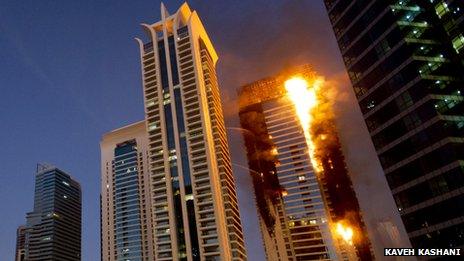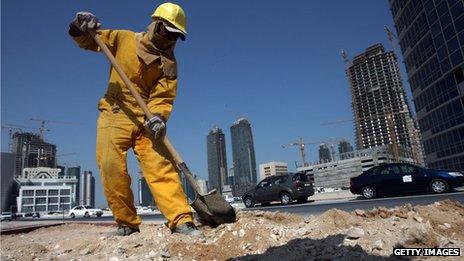'Towering inferno' fears for Gulf's high-rise blocks
- Published

There were no casualties in the Tamweel Tower blaze in Dubai, but the building was gutted
Fears of a "towering inferno" disaster in the Gulf are growing after fires left residential buildings heavily damaged in the United Arab Emirates cities of Sharjah and Dubai.
The Arab Gulf states are home to some of the most spectacular high-rise towers in the world. But some building experts say that many of those towers are sheathed in a highly flammable material that puts occupants at risk.
One expert in the UAE has estimated that 70% of the high-rise buildings there have panel facade cladding made of a combustible thermoplastic core held between two sheets of aluminium.
When the panel ignites, fire spreads rapidly, racing to the top of the building and sending flaming debris hurtling to the streets below. "Like a Roman candle" is how one observer described it.
The initial cause of the fire can be something as simple as a discarded cigarette butt or a charcoal barbecue left unattended on a balcony.
A fire at the Al Hafeet Tower in Sharjah on 23 April was eerily similar to a blaze that gutted the Tamweel Tower in Dubai last November. And the 40-storey Al Tayer tower in Sharjah also suffered a similar fate in April 2012.
In all three cases fire roared up the sides of the building as individual panels ignited and burst into flame. No deaths were reported from any of the fires.
"[The facades] are good-looking, long-lasting and easy to maintain, but they have one big problem - they burn rapidly," Thom Bohlen, of the Dubai-based Middle East Centre for Sustainable Development, told the BBC.
Lack of investigations
Mr Bohlen, the institute's chief technical officer, said that the UAE has passed new legislation banning the use of flammable facades, but it only applies to new building construction.
"That doesn't take care of the problem with current buildings", he said, adding the costs of refits will be "extremely expensive".
Mr Bohlen estimates that "at least 500 buildings" in UAE cities are sheathed in the flammable panels.
The sheathing has not been used in the UK since the 1980s and codes in the United States specifically prohibit their use in buildings of more than three or four storeys, he said.
Mr Bohlen is not alone in voicing concerns about the risk of fire in many of the high-rise towers that pepper every major Gulf city - or about the failure to pin down what is causing many fires.
At a recent health and safety conference in Doha, the capital of Qatar, another expert spoke of a huge number of fire incidents that had not been properly investigated.

The Gulf's high-rise towers pose huge challenges for firefighters
Steve Wood is the safety and health director for the Middle East division of the giant US technology corporation AECOM.
According to a local Qatari newspaper, Mr Wood told delegates at the Institute of Occupational Safety and Health (IOSH) meeting that in 2012 alone the causes of more than 1,000 fires in Qatar remain unknown.
"The reason why it's not known is maybe because they are too busy extinguishing fires and not resourced enough to investigate them," he is quoted as saying.
Qatar, with its huge gas reserves, is per capita the wealthiest country in the world. It has spent billions of dollars in recent years on enormous building projects that have radically transformed the Doha skyline.
But sufficient money for fire investigation appears not to have been set aside.
Like other Gulf countries, Qatar has regulations and legislation on the books, mostly modelled on the United States and the UK, but at the conference Mr Wood was quoted as saying codes are open to interpretation.
"Some clients may go for the least strict requirements, thinking 'which ones are the least I need to comply?' "
Playing catch-up
Mr Bohlen says that the unprecedented growth of Gulf cities has meant that though the buildings go up with astonishing speed, regulation and adequate enforcement lag behind.
That is because codes are simply adopted from other countries, but the context and enforcement mechanisms in which those codes developed are often missing or lacking in comprehensive application.
"There is not a lot of code depth in the Gulf. Codes are borrowed and it takes a long time to develop [codes]. They are coming but they haven't caught up," he says.
Mr Bohlen believes that there are still Gulf authorities that need to adopt unified fire codes based on international standards that are very stringent about the materials that can be used.
And he also believes that the potential risk these buildings pose should be brought to public attention.
Occupants of residential towers that burst into flames have spoken about the lack of fire alarms at the time of the blaze but most seem unaware that they and their families are living in potential firetraps.
Although some Gulf governments have expressed concerns and are revising and updating their practices, safety still appears to be taking a back seat in the headlong rush to build.
Focus minds
And with huge expatriate populations and acute housing issues, authorities have more often than not turned a blind eye, allowing contractors and owners to make decisions that could have disastrous consequences.
Mr Bohlen says that what might serve to focus minds and help to avert a towering inferno tragedy are insurance companies.
"They will ultimately find and force a solution because the financial implications for them of a series of fire disasters is not something they will want to deal with," he says.
But whether it is properly enforced tough regulations or expensive refits driven by insurers, Mr Bohlen is certain of one thing: "This is definitely a problem that needs to get resolved."
- Published14 April 2013

- Published16 January 2013

- Published14 May 2018